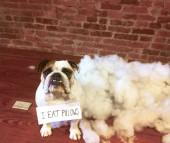 Eating non-food items could spell problems
Eating non-food items could spell problems
Pets that have eaten something they shouldn’t have represent one of the most common problems we see in the veterinary field. Dogs tend to be chewers by nature, but chewing can extend beyond normal bones and dog toys to include unexpected objects as well as a variety of inappropriate foods.
Of course, these things don’t just get chewed up – they often wind up being swallowed! Ask any veterinarian the weirdest things a patient of theirs has eaten and you’ll undoubtedly shake your head at the answer.
Socks, rocksand diapers
Here are some of the more common items that are ingested by pets:
Socks, underwear and women’s hosiery
Toys
Sticks and rocks
Bones
Corn cobs
Stringy materials (ribbons, hair ties, dental floss, Christmas tree tinsel)
Diapers and feminine products
Could cause illness
When foreign material becomes lodged or stuck, it can cause your pet to become painfully ill and lead to serious intestinal or other internal damage.
If this happens, immediate medical treatment is necessary with surgical intervention required in some cases. Once an object is swallowed there are only three ways it can come out: it can be vomited back up (either by the pet or with assistance by your vet); it can pass naturally all the way through the GI tract; or it may have to be retrieved surgically from the stomach and/or intestines. The last way is certainly the most expensive and invasive, typically requiring hospitalization for supportive care.
Symptoms
How do you know if your pet swallowed something they shouldn’t have if you didn’t see it happen? The most common symptoms a pet owner will see include:
Vomiting
Lack of appetite
Lethargy (becoming “quiet”)
Diarrhea
Constipation (smaller amounts of stool than usual)
Painful belly or abdomen
If any of these symptoms are noted or you have reason to believe that your furry friend may have eaten something potentially dangerous, you should contact your veterinarian immediately. Don’t try to let an object pass on its own without a medical consultation. The longer these things sit inside your pet, the more damage that can occur to internal organs. In addition, dehydration and electrolyte imbalance can occur quickly in cases of gastrointestinal obstruction, with vomiting and diarrhea greatly complicating your dog or cat’s overall condition and need for aggressive medical care.
Once your veterinarian examines your pet, he or she will come up with the best treatment plan. This will most likely include taking x-rays to see the location of the foreign object and if there is an indication of a gastrointestinal obstruction. Some items, such as fabric, may not show up well on an x-ray. In those instances, additional imaging may be required, such as an ultrasound or barium (dye) study. Once the vet knows what the object is, or at least its location, a course of action can be determined, taking into account the animal’s current medical condition.
Size matters
A large Great Dane that has eaten a small piece of a rubber toy which appears to be passing through normally may not require any treatment at all. On the other hand, a Chihuahua that has consumed 10 hair ties may need surgery.
Another complicating factor in foreign object ingestion cases is the length of time the material has been inside the animal’s body. Pets who don’t receive medical attention until several days or more after the ingestion has occurred typically suffer the most serious medical complications. This will likely require them to be hospitalized for supportive care, which may require intravenous fluids and electrolytes to stabilize them prior to possible surgical intervention. The more time a foreign body is stuck in one spot within the GI tract, the more damage is done. This situation can lead to a higher risk of complications, such as perforation through the GI tract, along with leakage of intestinal bacteria into the rest of the abdomen. This is an extremely critical scenario that can be fatal to your pet, even with emergency surgery.
How do you prevent your pet from eating the wrong things? The key is to understand the behavior of your dog or cat. If you’re aware Fido enjoys chewing and shredding stuffed animals, then it’s time to find an alternative toy for him. If Rover is consistently getting into the garbage, be sure to get a garbage can with a lid and place it where he does not have access. We often explain to our clients that a closed laundry hamper is a lot cheaper and less painful then surgery to retrieve a sock obstructed in Fluffy’s intestines!
Remember that all animals should be supervised around the house and outdoors. This is especially true when introducing a new toy or bone, and when your pet is young and “getting a taste” of life in your world. Don’t leave loose objects around and in reach of your dog or cat. Also, consider keeping them in a crate or small room, away from temptation, when you’re not home to supervise. Most important, learn to think like your pet. The two of you are sure to have very different ideas about what is tastefully tempting!
